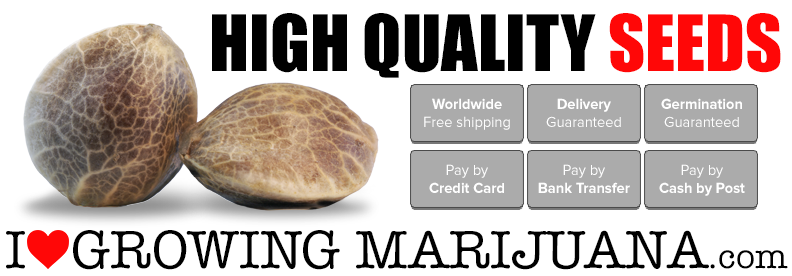How marijuana plants grow
Learn the basics

The growth process of a marijuana plant is more than just placing a seed in soil and watering. To achieve the best results with quality marijuana seeds, it is necessary to pay attention to the growth process of your marijuana plants. Knowing how marijuana plants grow best will help you with that considerably.
On this page we provide important information about achieving optimal results when growing marijuana plants. Read it carefully and discover the secrets of optimally growing marijuana plants.
Maximum growth and flowering
There are many influences and processes that affect the growth of your marijuana plant. Often, essential elements are missing, which causes your marijuana plants not to reach full growth and bloom potential. In this case, your harvest will be limited, which is a waste of efforts.
Three essential elements for growth
A marijuana plant needs three essential elements to live. These are: water, carbon dioxide and light. Thanks to these three substances, a marijuana plant can produce its own nutrition and oxygen and grow in a healthy way.
Uptake of growth elements
To take up the three elements, the marijuana plant uses; the roots, the stems and the leaves.
- The roots are used to absorb the water from the ground. That water is then transported to the leaves via the stalks of the marijuana plant.
- The leaves have small openings (stomata) to remove carbon dioxide from the air.
- The leaf green granules in the leaves catch the light.
The most important nutrition sources for your marijuana plant
The nutrition that the marijuana plant needs is glucose (sugar). In addition, the marijuana plant needs oxygen. A marijuana plant converts carbon dioxide and water into glucose and oxygen. The plant needs energy for this process. This energy is obtained by the absorption of (sun) light. This process is called photosynthesis.
To feed the roots, about 30% of the glucose produced goes directly to the roots. Excess glucose is stored in the soil around the roots for later use and where it serves as nutrition for other soil life.
Growth and development
A plant grows through the expansion of existing cells and the formation of new cells. The energy for this is obtained from the combustion of glucose produced by the plant itself.
In addition to water, carbon dioxide and light, the further growth and development of the marijuana plant is influenced by other important factors such as temperature, humidity, and nutrients. If one or more of these factors are not optimal, this will have a direct effect on the development of the marijuana plant.
Ensure optimal soil life
A healthy soil is full of life. Fungi and bacteria together with the plant form a perfect society (symbiosis) based on barter. However, the soil in which marijuana plants are grown is usually not in optimal condition.
Particularly soil sold in garden centers and DIY stores. This soil has been made sterile for the prevention of pathogens or weed seeds. With this type and many other types of soil important fungi and bacteria are missing.
Because this soil is lacking essential fungi your marijuana plant will not grow optimally, and the harvest will be poor. That is why it is important to add mycorrhizae and to bring the soil life back on track.
The most important fungi and bacteria for a marijuana plant are the Mycorrhiza fungi and Rhyzo bacteria. These protect the roots and supply hard-to-reach nutrients to the plant. In return, they get glucose. With this bartering trade an optimal soil life is created.
Germinate with Spongepot
Especially for the germination of marijuana seeds we have developed a convenient germination kit: the Spongepot. The Spongepots are packaged moist and thus retain their airy structure, allowing the roots to grow easily. Due to this airy structure and the added coconut soil, an optimal air-moisture ratio is created.
The risk of over watering is therefore very small. The soil of this germination kit is organically glued and due to the mix of peat and coconut, the sponges will not disintegrate when repotting. The premature root system remains intact and your marijuana seedlings catch on faster after repotting.
Mycorrhiza fungi
Mycorrhizal fungi consist of extremely thin fungal threads and grow explosively. A teaspoon of soil can contain a kilometer of fungal threads. Because these wires cover a large surface of the soil, they extend far beyond the roots of your marijuana plant.
The fungi can also reach the smallest soil pores due to their minimal diameter (3 microns) which is exactly where valuable nutrients are stored. Mycorrhizal fungi must be mixed through the soil and will start to work as soon as the roots make contact with the fungus.
Rhyzo bacteria and Trichoderma fungi
Rhyzo bacteria live mainly in the top layer of the soil. There they convert fallen leaves, old dead roots and excess sugars from trees and plants into important nutrients for your marijuana plant. In addition, they form a protective colony around the roots. Thanks to their physical presence, pathogenic bacteria no longer have room to nest around the roots.
Trichoderma fungus
This fungus is a super-fast growing fungus that encapsulates the young roots of your plant and forms a protective layer on the root. Since the Rhizobacteria with added Trichoderma fungi is provided to the water from day 1, the germ already comes into direct contact with the fungus. This protects the young vulnerable roots from day one.
More information about Rhyzo bacteria and Trichoderma fungi





